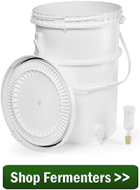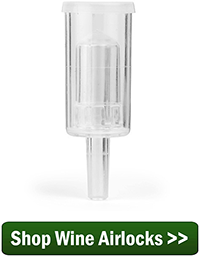 My kit wine calls to immediately put the contents of the juice, wine yeast, etc. in an air-tight container with an airlock. However all over your site it says NOT to put it in an air-tight container for the first 5-7 days because it will inhibit the growth of the wine yeast. Can you clear this up for me?
My kit wine calls to immediately put the contents of the juice, wine yeast, etc. in an air-tight container with an airlock. However all over your site it says NOT to put it in an air-tight container for the first 5-7 days because it will inhibit the growth of the wine yeast. Can you clear this up for me?
Name: Dennis
State: North Carolina
—–
Hello Dennis,
It is a matter of weighing all the pros and cons differently.
The reason you use a fermentation airlock is to protect the wine from contamination. If you leave the lid and airlock off the primary fermenter and the fermentation begins in a timely manner and ferments vigorously, there is very little chance of the wine becoming compromised in any way. Not only is the CO2 gas rapidly rising off the fermentation, protecting it from fall-out of airborne nasties, but the vigorous activity of the wine yeast themselves are also destroying any contaminants that may make their way to the liquid.
The harder the wine ferments, the more protected the wine will be, and the sooner your wine will have completed its fermenting.
Wine kit manufacturers say to themselves, “we do not know that everyone’s fermentation is going to start as it should. What if it doesn’t and the airlock is not being used? Then there is a possibility of the fermentation being taken over by a mold or bacteria. We would rather be safe, because we are not sure every single fermentation will start-off as intended.”
- Leaving the lid and airlock off will allow the primary fermentation to start sooner and continue more rapidly, but it can also leave the fermentation susceptible to contamination should it not start in a timely fashion.
- Leaving the lid and airlock on will keep the fermentation much more protected, but it will cause their primary fermentation to go more slowly.
I would like to point out that keeping an airlock off the primary fermentation is not something we made up. It is regularly practiced in the wine industry. It is also the typical way a fresh fruit wine is made by home winemakers.
Also, I would like to make it clear that we are only talking about the primary fermentation. As the fermentation starts to slow down, and it becomes time to rack the wine into a secondary fermenter, you should always be using an airlock. The same holds true if the fermentation is not starting out as strong or as quick as it should; put the lid and airlock on until you see the fermentation is going.
As a final point, whether or not you use an airlock during the primary fermentation, the wine will be made. It’s a matter of how fast and vigorous the fermentation proceeds, not a matter of whether or not your wine will turn out, so don’t feel that it is a critical decision because it’s not.
Happy Winemaking,
Ed Kraus
—–
Ed Kraus is a 3rd generation home brewer/winemaker and has been an owner of E. C. Kraus since 1999. He has been helping individuals make better wine and beer for over 25 years.


I beat/whip air into a portion of water being added to the must or some of the must itself using a blender. After adding the yeast I snug the lid down tight and set the airlock in place at once. I’ve gotten a good roiling ferment every time I’ve done this.
I got the idea out of Ken Schramm’s book on mead making.
I use a clean tea towel to cover my fermenter and a stretchy belt/material to hold it in place. I keep my primary fermentation warm with a heat belt; usually about 75F or 23C; have had no problems with mold; key is to get the temp right as quickly as possible so yeast starts working fairly quickly.
I’ve used cheesecloth to keep any bugs out. When fermentation slows, use an airlock. I don’t leave the must with cheesecloth the whole primary process. I love the way the kitchen smell when fermenting vigorously.
I like to jump start my yest by adding it to 80F water and sugar and then adding to my mixture and at once using my airlock and i get fermentation real soon. However, i wonder if add the technique adding air to my water by way using the blender would give me better results!
Arron, you can do that if you want. However, since the blender could be hiding particles somewhere that you cannot see, you will want to be sure to add sulfites to kill any bacteria that could be in the juice. After doing so, you will want to cover the fermenter with a towel and wait 24 hours before adding the yeast so that the sulfites can dissipate. I think it would be much easier to just cover the fermenter with a towel during the primary stage of fermentation to allow oxygen to reach the yeast.
Question i started a batch 5gallon of wine made from welches grape juice sugar and yeast with an air lock fermenting fast and great but it bubbled up into the airlock is that bad?
Lisa, it sounds like you had a very vigorous fermentation or perhaps you need a little larger fermenter to allow for foaming. I would just clean and sanitize the airlock and everything should be fine.
Today I am making my first batch of wine and I like the covering idea with a cloth better, but since I live in an older home close to a river, could I spray Campden water on the cloth to be safe from possible mold in the air? I have learned that Campden water puts out gases, but I don’t know if these gas would harm my wine? Maybe mist the cloth once a day? Lol, I am so nervous like this first batch is a baby! Any thoughts on this would be appreciated!
Penny, you put campden tablets in the wine to protect it from spoilage so it would be fine to spray down the cloth with a sulfite solution.
Hi everyone,
This is my first attempt at making homebrew. I started with 5 lb persimmons + sugar, water, yeast & yeast nutrients.
Within 24 hours, I notice lots of foams and pulps ? Are floating to the top.
Q: am I supposed to filter those yucky stuff away or just keep stirring everyday and hope it would eventually become sediment ?
What’s the next step after this ? Appreciate any suggestion/help.
Thanks
Kristie, the foam that you see is normal fermentation activity. The fruit pulp is part of the fermentation for the primary stage of fermentation, which is the first 5-7 days. After that you want to remove and discard the fruit pulp. While the fruit pulp is part of the process, you do want to stir it daily to prevent the pulp from forming a dry cap and suffocating the yeast. Below we have included the link to our Persimmon wine recipe that provides step by step directions.
Persimmon Wine
http://eckraus.com/content/persimmonwine.pdf
I make great wine from ALL tropical fruits 12-14%alc.volume by following these:
1) make your 5 gallons bath, add 1/2 tea spoon campden to kill bacteria, cover with clean tissue
2) next day check SG = 1.080/90 no less, no more. Add yeast. Do not shock dry yeast with hot or worm water. Activate em in same temperature water as your must bath. Add 1/2 teaspoon of sweet water from bath and watch 10-15 min your yeast covered with foam. Ready to go. Cover your fermenter, next hour use a spoon to mix it very gently.
3) for the next 4-5 days steer your must 2-3 times a day, let the yeas colony grow
4) check SG=1.040 or less, add 2lb of sugar (dissolve it in same must well). Keep the fermenter under tissue
5) after full week you have yeast colony multiplied enough to make good wine. Take out all fruits/pulp, check if SG is losing 10 pips daily. If your hydrometer reads 1.030 or less – it is time to COVER YOUR FERMENTER with hard lead to prevent oxygen penetration and PLACE AIRLOCK.
6) watch bubbling, do nothing until fermentation is over (15-45days)
7) Rack the wine into 1 gallon jars, add 1table spoon of bentonite slurry to each gallon
8) After 1 week your wine should be clean and ready for aging. That is all.
Hi, Mate!
My first pineapple wine batch.
I started on April 11 with pineapple juice from real pineapple fruit mixed with sugar and starting up with SG read1090, on nextday added a red star premiere cotes des Blancs Yeast
today april 16, SG read 1010.
what should i do?
Thank you
I would bottle and drink.
Hi I am making my first attempt white wine! I bought a wine kit did the first step but my pail does not a a air lock does that matter?
Lorelee, during the primary stage of fermentation you do not need an airlock but after that it is necessary. If you do not have the wine under an airlock after primary fermentation, the wine can oxidize and spoil.
Air Lock
https://blog.eckraus.com/working-tiitle-air-lock-thing
Hi,Ed Kraus!
My first pineapple wine batch.
I started on April 11 with pineapple juice from real pineapple fruit mixed with sugar and starting up with SG read1090, on nextday added a red star premiere cotes des Blancs Yeast
today april 16, SG read 1010.
what should i do? please help
Thank you
I personally want a long, cool fermentation so I put the airlock on right after fermentation begins. I am talking about fresh white wine grapes. With red grapes, I keep the lid on the fermenter with the room temperature of about 68 degrees.
Hi , I am making wine for the first time, I seen a video in you tube a person making a wine from real canned apple juice, sugar and yeast. I did it in a same manner but i don’t know how to lock the bottle I just tied it in a cloth is it correct process, because air can eliminate through the cloth, make me clear whether it has to be covered fully tight or the with cloth is fine.
What you have done is fine for the earlier stages of the fermentation. The CO2 gas blowing through the cloth will keep it protected, but as the fermentation winds down, this can become an issue. The amount of gas will not be enough to protect the wine. This is when you will really need an airlock. If you cannot get one, you second best option it so stretch saran wrap over the clothe; secure it with a rubberband and prick a pinhole in it.
Hi,
How long after the airlock stops bubbling can you leave it to rest? and at what temperature should I reduce it to? I ask as I am waiting on delayed delivery before I can start the next stage.
In theory, you can leave the wine indefinitely that way as long as it is sealed up perfectly tight. In reality there are some other considerations. Either way once you open the container all bets are off.
You do not want the wine sitting on that much sediment for extended periods of time. 10 days max. So you should be racking the wine into a fresh container after that. Add sulfites and seal up tight.
You can reduce the temperature of the wine to discourage spoilage. That along with the sulfites is good. However, you should be aware that cooling down a fermenter with the airlock on it, can suck the water out of the airlock into the wine through contraction. So make sure you put a pinch of sulfite in the airlock water.
I am trying to make alcohol from quick yeast made from bread sugar and apple juice. This is my first time so I am not sure if it will even work any advise ?
It will work to some degree, but may not be able to ferment all the sugars due to the lack of nutrients. The bread will provide some nutrient, but I also recommend adding some Yeast Nutrient as well:
Yeast Nutrient
https://eckraus.com/yeast-nutrient/
I am attempting to make blueberry wine. I am trying to ferment in an old crock without a airlock. I simply have a clean cotton tshirt over the top that has a bungee cord sealing the top. I will stir everyday.
I have mashed the blueberries and have them in a cheese cloth bag. I have added the juice and yeast and other ingredients.
How will I know when to rack the liquid into the containers with the airlock?
I am guessing I can before I rack add the sugar and the water enough to make the 6 gallons? I have 2 3 gallon glass containers with corks and a clear hose placed in water. I was told this will work for the airlock.
The reciepe calls for 3 pounds of blueberries per gallon and 13 pounds of sugar total.
I wasn’t planning on checking the whatever levels with whatever instruments and doing the math for alcohol limits.
I will need bottles if I can order them from you.
Mark, you should be adding the sugar when you add the rest of the ingredients in the beginning. As far as when it is time to move it to the secondary fermenter, this is typically around 5-7 days or when the specific gravity reaches 1.020-1.030. For more information, please see the article link below. Yes, you can purchase wine bottles on our website or by contacting us by telephone.
When Do I Move My Wine to The Secondary Fermenter
https://blog.eckraus.com/when-to-move-wine-to-secondary-fermenter
This is our first attempt at winemaking and we used Camden tab on frontanac grape must. The man who worked in wine supply store said to wait 48 hours just to make sure instead of standard 24 hours. The initial ph was 8.2. We did not do Brix til after 48 hours and that was too high so we added water to correct and then also added Ca carb to bring down the acid. The wine supply guy sold me 71B yeast which I started in warm water with some sugar and then added nutrient before putting in two different must pails ( since we added water) after 10 min. Guess it should have been 20 min but I just put it on top and did not stir in. I’m not sure if the yeast is great or not because the next morning the small extra batch smells good and yeasty but no foam and the big bucket batch smells sour! Will I need to throw it out? I am trying to start more yeast since I did not use the whole package since I read that yeast packages are good for 5 gallons must and I am only doing what I thought was one gallon but the adjusted to 1.5 gallons.
Unsure what to do?
Thanks,
Kathy